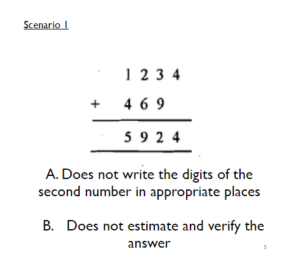Online Teacher Professional Development: Lessons from Puducherry
By Gowthama Rajavelu and Naveen Kumar
Introduction
Pandemic-induced online forums have become a part of today’s education. The number of people attending classes online has increased exponentially since the lockdown. Schools, colleges, institutions, non-governmental organisation (NGOs) have been conducting classes/trainings for a wide range of stakeholders.
As part of the Azim Premji Foundation, which is working with the goal of developing teacher capacities, we also started designing online forums for teachers. The prime focus of our work is towards early literacy and numeracy, as emphasised in our National Education Policy 2020. This article presents, in detail, the planning, designing and transacting a course on teaching Mathematics in the primary grades.
Background
Puducherry is a small town, with a 25km radius on all four directions. There are five educational blocks in the district with a total of 271 schools including primary, higher primary, high schools and higher secondary schools. There are 1006 teachers who work in the primary grade (1-5) in 151 primary schools and 33 middle schools. Our work primarily with these teachers.
Planning
Objectives and course content
According to Tom Guskey (2000), clarity of goals in terms of classroom practices and student learning is important for an effective professional development program. According to the book, Designing Professional Development for Teachers of Science and Mathematics (Susan Louckus-Horsely et al, 2000), understanding students and their learning needs is at the heart of professional development design.
We thought of making teachers think in terms of learners – children’s thinking and challenges. Hence, we planned to use students’ written work, classroom video of students’ responses, students’ audio responses to make teachers understand how children learn. This approach of keeping children’s thinking and learning at the centre would allow for the teaching approaches to be developed as a response to how children learn and think about mathematical concepts.
Considering the above points, we planned to achieve the following objectives:
- Develop the understanding of cumulative nature of mathematics and the importance of strong foundational understanding in the early years for developing mathematical thinking.
- Understand the importance of the [Concrete à Pictorial à Abstract] approach in the early years of teaching-learning mathematics.
- Understand children’s difficulties in learning mathematical concepts in the early stage.
We planned the workshop content around the theme ‘numbers and number operations.’ Using this theme, we thought of highlighting the cumulative nature of the subject and the way it progresses to the secondary level. The session topics were as follows:
- Number sense
- Place value
- Addition and subtraction
- Multiplication
- Division
- Fraction and decimals
In the sections below we detail the approaches attempted to make the sessions effective and how we evaluated the effectiveness of the program.
Online engagement: Choosing the platform
We chose Google Meet as the virtual platform for online teacher engagement, though we had access to complete features of Microsoft Teams. Despite the limited features in the free version – voice and text chat only – we preferred it, as teachers were familiar with the platform. The Education Department had conducted many trainings for teachers during the lockdown on Google Meet.
Rehearsal or dry run of the session
It is important to bring a third-person perspective into any plan, to gain insight and to validate it against the intended outcomes. In the dry-run, observing members (Teacher Educators) took multiple roles – they responded from teachers’ perspective, they suggested changes in the content/flow based on their experience with teachers and children. The dry run also served another purpose. It exposed the members who were working in other subject areas to the teaching of mathematics.
A dry run is indispensable to the smooth transaction of online forums for teacher professional development whenever new content is to be transacted. We realised that it is important that the dry run is done on the same virtual platform in which the session will finally be conducted. It gives an idea regarding how the content will be received at the participants’ end. For example, in our case, teachers connected through their mobile phones. So, we had to check beforehand how the PowerPoint presentation, video etc, would appear on the mobile phone screens. The dry run helped in fine-tuning the session to enhance the participants’ experience.
Online engagement experience
Challenges of the platform
Although, we have good experience in conducting teacher forums, that were face-to-face engagements before lockdown, this sudden switch to the online mode was not easy and the transition happened slowly. We initially had difficulty in delivering the content and teachers took some time getting used to the online platforms. Generally, teachers are interactive during face-to-face sessions, which was not so in the online mode. Initially, most of the teachers had trouble interacting with the interface of the platform – how to unmute? How to chat? How to join the session? How to project their screen?
Discussion plays a central role in our face-to-face teacher sessions engagements for teacher professional development. In the online program, the interaction level limited, for example, participants would forget to ‘unmute’ to speak. Also, we were often unsure if our voice could be heard by all and that there were no problems with the internet connection or the headsets, etc.
Initiating discussion and enabling interaction
Only when we create dissonance with problematic practices and beliefs, can we create the need for new practices and introduce these meaningfully. One of the most important elements in any professional development program is student learning. Teachers must be made to think and deliberate around it. For this to happen, we consciously included classroom scenarios in the beginning and made teachers think about their own students.
We found it difficult to make them talk about classroom experiences or respond to open-ended questions. So, we included multiple-choice questions after each scenario where teachers could choose options and respond in the chat box.
This is an addition problem solved by a grade IV child. Where do you think the child struggles?
Figure 1. Illustrative work of students to elicit teachers’ opinions
The above classroom example was presented to establish the importance of developing a ‘number sense’ before moving to number operations like addition. Here, most of the teachers said that the child did not understand the concept of place value. However, there is another problem here, which is that the child does not seem to have a sense of estimation. If only, the child had a sense of estimation, he could have corrected it after seeing the answer. The fact that he did not, conveys the child’s problem with number sense. Such examples highlighted the need for developing a sense of numbers, for example, comparing numbers even before moving to number operations.
In addition to this, simplifying questions to yes/no-type helped increase participation. For example, rather than asking, what is the difference between memorising and constructing the multiplication tables? Posing the question in the following forms elicited several responses:
Do you think memorising multiplication tables by repetitive recitation and repetition will help children in solving problems? Yes or No
Do you think memorising multiplication tables through repetitive recitation will help children in developing reasoning skills? Yes or No.
While attending trainings over mobile phones, these kind of questions with simple responses were easier for the teachers to respond. Such questions motivated even the ones who do not respond in forums or avoid interaction.
Making teachers think
Mathematics has always been considered abstract, but it is not and hence, the need for concrete activities is more in the early years. To convey the importance of concrete activities, we posed a question as shown in Figure 2. The initial answers from teachers were: 3, three, number. We further probed them saying how will you explain it to a person who does not know the symbol 3. After a long pause, one or two teachers suggested that they would show three things and convey the meaning of the symbol 3. There were some thinking moments where we felt that the teachers realised the importance of thinking in terms of children and modifying the teaching strategy accordingly.
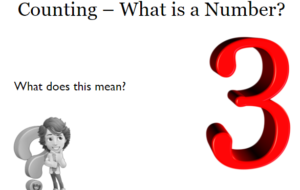
Figure 2. A situation to understand importance of concrete activities
In addition to building interaction – through texts in the chat box – such scenarios make teachers think when the discussion is around a real student problem and help them identify the problem with their existing practices. On the same lines, instead of discussing what is multiplicative reasoning, we posed the following work of children and asked, ‘Which student has multiplicative reasoning?’
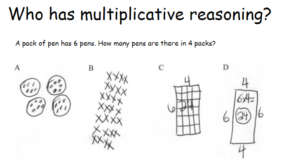
Figure 3. Students’ work used to understand the need for developing multiplicative reasoning
While most of the teachers said that all the approaches were correct, a few teachers pointed out that Student C and D were able to solve this problem quickly compared to Student A and B. One teacher added that Student D might be good in multiplication tables so was able to solve the sums fast.
We took the discussion to the level of making teachers think in terms of skills involved in solving the problem. Student A used counting through grouping model, Student B used repeated addition through array model and the other two students used multiplication through area model. This helped in discussing three different approaches to make a student progress from additive reasoning and multiplicative reasoning.
Children’s voices add value to the forum
Another element that could create boredom in the listeners on an online forum is the voice. Participants may lose interest if there is only one facilitator, so it is better to involve two or three people to facilitate the session. Besides facilitators, we have included children’s voices during the session that worked well in terms of interaction.
Before the session, we sent a few questions to students and got their responses. Fortunately, some teachers were still working with their children even in this unprecedented situation and we got help from them for this activity.
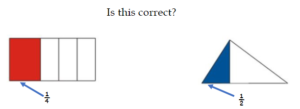
Figure 4. Student’s voice responses to this question were used to understand how children think
It is a textbook problem (NCERT grade IV) and the voice responses of two children were played as follows:
Student 1: Both are wrong as 1 in the first picture is big and 1 in the second picture is small.
Student 2: It should be equal. So, the first picture is correct. In the second picture, it is not equal. So, it is wrong.
We included these voices in the presentation and played it during the session. Many teachers opened-up after listening to this as the related this to their classroom.
One teacher said, ‘Most of the students have issues with half and quarter. They consider the divided portions as equal irrespective of their size and area covered. We explain to them through paper folding and then, they get clarity.’
Another teacher added, ‘Students see the shape and get confused. In the first type, it is a rectangle and is divided into four parts so many students consider the shaded part as quarter because the shaded part is one out of four divided parts. Whereas the second shape is irregular as it doesn’t look like the triangle given in the textbook. So, looking at the shaded portion, which looks small compared to the unshaded portion, they say it as wrong.’
Yet another teacher added, ‘Students might get it wrong the first time but with repeated practice, they can get it right.’
Children’s voices enabled them to think in terms of their classroom, which holds good for any professional development program.
The first response highlighted that the student got the correct answer, but the reasoning is not perfect. The second response shows that student considers the equality of shapes and hence, chooses the first picture to be correct and the second picture to be wrong. This helped us talk about the misconceptions regarding fractions and why we need to move beyond getting the correct answers and focus on developing reasoning abilities.
Questions from our members
As mentioned earlier, we could not see much interaction from teachers for questions during the online sessions. Then we made our own members (APF RPs) participate during the discussion. They responded to the questions in the chat box and after some takes, there were more responses from them.
Sometimes, our members also posed questions that were critical to highlighting a point or taking the discussion forward. For example, how to teach that division by zero is not defined, what kind of activities can be used to teach the concept of zero etc.
These questions encouraged teachers to participate in the discussion, at least by responding in the chat box. Another element is that they must feel that questioning is an important part of the classroom process, and it can come from anybody. However, it must be handled cautiously as teachers should not feel manipulated by us. Another way is to talk to a few teachers beforehand and ask them to be interactive during the session.
Video demonstrations
After developing the need for an approach around children’s learning, we also demonstrated the use of teaching-learning materials live on video, as this would convince the teachers of the possibility of doing these activities in the classroom and also develop an understanding of how to use these materials in the classroom. These demonstrations not only added variety to the sessions, but they also provided opportunities for discussion.
In fractions, there is a problem with understanding when two parts can be said to be equal halves, as many consider the parts should be symmetrical and of the same shape. Some teachers also had this misconception. They did not consider the following shapes to be divided into equal halves. This could be verified by cutting the parts and placing one above the other and checking for overlap. While this could be done easily during a face-to-face engagement, in the online mode, a video demonstration helped in showing them by cutting and placing one part upside-down above the other part both parts are equal.
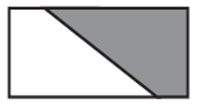

Figure 5. Are the shapes divided into two equal halves?
When the shape in figure 6 was shown, some teachers said that the shaded portion does not represent a quarter. They believed that if the shapes are different, parts will be unequal. Even if the shapes are not the same, the parts can be equal. We used a dot-sheet and demonstrated that though the shapes are different, the area is the same and hence, the parts are equal. Addressing these misconceptions were possible only through video demonstrations.
Figure 6. Does the shaded portion represent 1/4th?
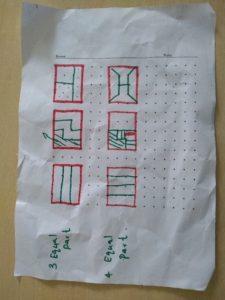 Figure 7. Dot-sheet demonstration of 1/3rd and 1/4th
Figure 7. Dot-sheet demonstration of 1/3rd and 1/4th
As a follow-up to the session, we re-recorded the activities and uploaded it on our YouTube channel for the benefit
of teachers. You can see it here.
Attractive PowerPoint presentation
In a face-to-face session, the facilitator can always know the participants’ state of mind and can crack a joke or play a game to break the monotony and capture their attention. Also, during a face-to-face interaction, PowerPoint presentations are only secondary; the facilitator is the primary point of interaction. In online sessions, PowerPoint presentations play a central role in keeping the participants engaged as the facilitator cannot see the reaction of participants and the participants cannot see the facilitator.
Relevant pictures and limited text with a readable font size are important. As most of the teachers are attending through their mobile phones, it is better to check how the font used would look on the mobile screens. And for the number of slides, 30-35 per 1.5 hours session worked for us. Retention time per slide can be less than 3 minutes otherwise teachers might get distracted at any point. Even if they are distracted at a particular point, transitioning the slides at this rate can draw their attention to the next slide making them aware that the discussion has moved on.
Duration of a session
In our context, we realized that since it is an online forum and almost all the teachers attend it using their mobile phones, it is not advisable to hold a session for over 1.5 hours. Participants might get distracted or their mobile phones get heated or any such problem may occur.
Evaluating effectiveness of the program
The book Evaluating Teacher Professional Development (Guskey,2000) identifies five levels at which teacher professional development must be evaluated.
Level 1. Participants’ reactions
Level 2. Participants’ learning
Level 3. Organization support and change
Level 4. Participants’ use of new knowledge and skills
Level 5. Student learning outcomes
We also realized that during our face-to-face meetings, we have been mostly capturing the participants’ reactions about the program, which is mostly positive but provided no information about their learning. We refrained from assessing participants’ learning as it may seem threatening to them.
In these changed circumstances, where the schools have not yet reopened, it is difficult to evaluate levels 3, 4 and 5 mentioned above. We minimized our evaluation of participants’ reactions and focussed on participants’ learning. We used Google Forms to conduct the post-course survey.
One finding from the survey is that, after the online program, some teachers did not believe in reciting and memorizing multiplication tables. Because the point of constructing multiplication tables through various experiences (activities and games) was conveyed repeatedly in the session. Such responses made us believe that our content has been delivered well. However, some teachers still considered ‘memorising tables’ valid in learning multiplication, which made us realise that certain beliefs are very difficult to question or change.
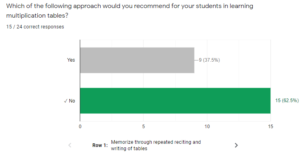
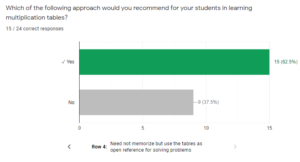
Figure 8. Teachers’ responses on learning multiplication tables
Conclusion
A good teacher professional development program must have these three characteristics:
- Create a dissonance with teachers’ existing problematic beliefs and practices
- Provide activities that resolve the conflict created.
- Enable teachers to develop a new repertoire of practice that fits with this new understanding.
We also realized that a one-off engagement spread over two weeks may not be enough to change the beliefs of all teachers. We need to present the same ideas in multiple forms to strengthen the understanding so that it translates into teachers’ practice.
Furthermore, careful scaffolding for teachers in terms of resource support in classrooms is indispensable for change in teaching practice to translate into an improvement in students’ learning outcomes.
AUTHORS
Gowthama Rajavelu, Resource Person, Azim Premji Foundation, Puducherry
Naveen Kumar, Resource Person, Azim Premji Foundation, Puducherry


